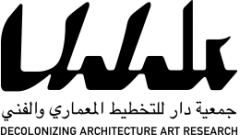Common Assembly: Deterritorializing the Palestinian Parliament is a long-term project to think through and conceive of spaces for political participation, decision and action for all Palestinians. This autumn, the United Nations will vote on whether to recognize Palestine as a sovereign state and a member of their assembly. This event’s arrival on the heels of other liberation struggles throughout the Middle East makes it a historic moment with great potential. Whatever the vote’s outcome, Palestinians must deal with a significant spatial problem: how can political participation be organized for a partially exiled—and therefore, geographically dispersed—people?
Where different revolutionary initiatives launched by Palestinian academics and various factions seek to address this problem on the political and institutional level, DAAR is committed to thinking through this problem on the architectural, territorial and (extra) territorial levels. The studio has been granted access to the Palestinian Parliament building in Abu Dis. It was constructed with international donations during the Oslo years but the project was abandoned before completion. Now the Wall cuts the building off from Jerusalem. The building stands as a monument to the collapsed peace process but this condition of local impossibility allows for a political imaginary to arise. Thus, the building becomes a starting point to imagine new types of political assembly.
DAAR decided to use the building both as a site of intervention as well as a site of architectural speculation. DAAR’s goal is to work through an understanding of the relationships between territory, population and political representation. In Palestine, the population cannot be represented by a single parliament building, as it would serve only a people within imposed borders that fragment all those who see themselves as Palestinians; it must operate through disassociations in which the people, the building and the territory are categories in constant motion in relation to each other.
The Return to the Common
Territorially speaking, the common is different than both public and private. Both
private and public lands are relations between people and things regulated by the
state. The state guaranties private property and maintains public ones. Both private
and public lands are territorial mechanisms for the governing of men and women.
Sometimes this form of government operates by maintaining these distinctions and
sometimes by blurring them. The endless privatization of public space, mirrored by the
incessant intrusion of the public (as state agents/police etc) into the private domain
are both techniques of government control.
In Palestine, the idea of the public is particularly toxic. Although prior to Israeli
colonization there existed a wide multiplicity of collective lands, and collective uses of
land—agricultural, religious, nomadic, etc—upon occupying the land and excluding its
people, the state has flattened them all into one category—“state land” and seized
control over it as the sovereign. This state land was a public space but only insofar as
it was reserved to the only public that was acknowledged as legitimate—the Jewish-
Israeli one. As a result, the contours of public land become the blueprint for
colonization. This form of sovereignty was willing to acknowledge only Palestinian
individual rights and claims to private land. The mechanism of humanitarian balance
adopted by the state could only tolerate Palestinian presence as individuals, thereby
denying them a collective identity and existence. In many cases it also took this land.
A fundamental question surfaces: if it is possible to conceive of a political collectivity
beyond the idea of a state, then, from a spatial perspective, in which way is the
common different from the public? The idea of common land in our context is a set of
relations between people and things—organized by the principle of equality—that is
not mediated by the state. This common exists today in the extraterritorial dimensions
of the Palestinian refugee camps and is mirrored in the destroyed Palestinian villages
of 1948. The camps are UN administrated areas carved out from state sovereignty
(there is no private property in refugee camps) and the demolished villages of 1948 are
suspended spaces, existing in the form of “absentee properties” managed temporarily
by the state. After 60 years the memory of a single house is now equally shared by
hundreds of families. In the camp the common is the shared history of displacement
and the absence of private property. In this respect thinking the revolution as return is
thinking a revolution in relation to property.
Common Assembly
A project by Sandi Hilal, Alessandro Petti, Eyal Weizman, Nicola Perugini
with Yazeed Anani, Nishat Awan, Ghassan Bannoura, Benoit Burquel, Suzy Harris- Brandts, Runa Johannssen, Cressida Kocienski, Lejla Odobasic, Carina Ottino, Elizabeth Paden, Sameena Sitabkhan, Amy Zion.
With special thanks to Ghiath Nasser
